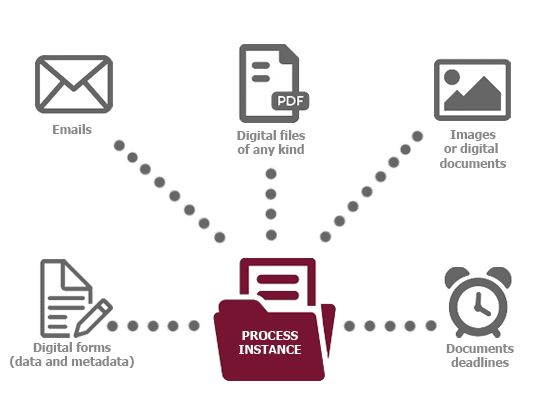This post will cover document management and its relationship with the workflow of these documents and the business process management discipline (BPM) paradigm and how to increase its efficiency. In other words, let’s see how to synergically integrate a Document Management system (DMS) into a Business Process Management System (BPM).
By documents, we usually mean:
- Physical documents (papers)
- Files, such as MS Word, MS Excel, PDF, etc.
- Mails
It is clear then that a document can be physical or digital. In any organization, documents are passed from one person to another to complete a certain task. We call this a “documentary process” or a process based on documents. Further, the instances of these kinds of processes include one or several documents.
In sum, a process instance may contain:
- Electronic forms with fields relevant to that process
- References to physical documents, being sent along with the process instance (and should not get lost)
- Attachments (MS Word, MS Excel, PDF)
- Mails that are relevant to the analysis of the process instance
- Alerts or deadlines of these documents
- Images (JPG, GIF), scanned files (TIFF, PDF)
- Etc.
Document management example
We can imagine that a sales process (described in this previous post) might include the following elements:
- Sales-lead form, with fields such as:
- Customer Name, address, email.
- Listed items to be sold, unit price, quantity
- Total Amount
- References to physical documents:
- Printed specifications of the products
- Attachments (MS Word, MS Excel, PDF):
- Costing sheet
- Different versions of the commercial proposal
- Final proposal sent to the customer
- Mails that are relevant to the analysis of the process instance:
- Questions asked by the customer
- Acceptance of the proposal by the customer
- Alerts or deadlines:
- Reminders to follow-up with the customer every 7 days
- Images (JPG, GIF), scanned files (TIFF, PDF):
- Product images
Metadata
Of all the above elements, the most important and interesting ones from the document management point of view are electronic forms that contain relevant fields for that process instance.
The interesting thing is that each process and workflow will have specific fields that are relevant to that process (and not others). Furthermore, you can define them, using a form builder, without programming
Continuing with the “sale-lead” example, the “Total Amount” field is relevant to a sales process but not to a Human Resources process.
These fields contain data describing the process instance. The “client” field identifies who it is that process instance for. Since these data describe other data of the process instance, we call them “metadata”.
A BPM Suite must allow flexibility in the definition of metadata. Moreover, since this metadata change, it is essential to manage it simply and quickly.
Searches on metadata
Once the metadata are well defined, it is essential to increase search accuracy. An advanced search engine allows retrieving the information and documents easily.
In our example, if we want to find all the sales made to the customer “ACME” we could increase precision defining to search…:
- within the process: “Sales”
- only inside the field: “Customer”
- for the keyword: “ACME”
Firstly, this will be much more accurate than searching the entire database for “ACME” which returns not only the “Sales” process but every process which includes customer “ACME” in any field.
Secondly, in any organization, and more so in a small business, knowledge is one of the main (if not the main) actives. Consequently, to have scattered it in mails and PC files is a major weakness that should not be overlooked.
Powerful search tools dramatically increase precision. In other words, they help us find documents quickly whenever we need them. Because of this, they are a key instrument for a better document management.
Conclusion
In a small business or big company, there are processes that often involve documents. It is crucial to increase organizational efficiency, and maximize the quality of service provided to customers, managing all these documents associated with each process. Furthermore, proper document management allows you to perform searches and optimally manage the knowledge within the organization, which is probably its greatest asset.
At Flokzu, we provide a fully integrated document management system into a powerful cloud BPM / Workflow Suite. In short, we invite you to a free trial of our Premium service. Start managing your documents and their flows right now 🙂
Schedule here to set up a document type and its workflow in just 30 minutes.




























